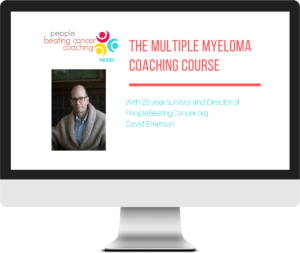
Recently Diagnosed or Relapsed? Stop Looking For a Miracle Cure, and Use Evidence-Based Therapies To Enhance Your Treatment and Prolong Your Remission
Multiple Myeloma an incurable disease, but I have spent the last 25 years in remission using a blend of conventional oncology and evidence-based nutrition, supplementation, and lifestyle therapies from peer-reviewed studies that your oncologist probably hasn't told you about.
Click the orange button to the right to learn more about what you can start doing today.
- You are here:
- Home »
- Blog »
- Multiple Myeloma »
- Multiple Myeloma – First Line Treatment
Multiple Myeloma – First Line Treatment

First-line treatment (sometimes referred to as induction therapy, primary therapy, or front-line therapy) is the first therapy that will be tried for all newly diagnosed myeloma patients.
A breakthrough of sorts occurred when overall response rates (ORR) for newly diagnosed multiple myeloma patients undergoing first line treatment elicited a response in 100% of patients. This breakthrough occurred in 2010.
I refer to this as a breakthrough because exposing the patient to chemotherapy without getting a measurable benefit makes no sense and risks short, long-term and late stage side effects. When I was diagnosed with myeloma in 1994, overall response rates were approximately 50% and newly diagnosed myeloma patients could expect and average life expectancy of 3-5 years.
At the time, the standard-of-care first-line treatment of Melphalan and prednisone.
What this means for the newly diagnosed myeloma patient is that your oncologist should be able to stabilize your health condition regardless of your age, stage or symptoms.
While oncology can stabilize most every newly diagnosed myeloma patient, and while the average 5- year survival rates continue to increase, unfortunately, oncology cannot cure the newly diagnosed myeloma patient.
Your goal as a myeloma survivor is to walk the fine line between undergoing enough toxic therapy shown to control your monoclonal proteins (your myeloma) while not undergoing so much toxicity as to damage your health irreparably and ruin your quality of life.
Multiple Myeloma First Line Treatment and Protocols
Years of research and clinical studies have developed an effective treatment plan for newly diagnosed myeloma patients. This treatment plan is what is referred to as the “standard-of-care.” This is the term term used by the Food and Drug Administration to give guidance to conventional oncology to indicate the efficacy of treatment regimens.
The standard-of-care treatment plan for all newly diagnosed myeloma patients is induction therapy followed by an autologous stem cell transplant followed by low-dose maintenance therapy. This basic therapy plan is designed to provide patients with the longest possible progression-free-survival. PFS is a fancy phrase for the patient’s first remission.
Unfortunately, in my experience, one standard-of-care, basic treatment plan designed to be the most effective treatment plan for all newly diagnosed myeloma patients insures that patients who are not “average” experience over treatment or under treatment depending on their age, stage and symptoms.
Common first-line therapy regimens for transplant-eligible patients include:
- Lenalidomide (Revlimid)/bortezomib/dexamethasone (VRd, RVd) [6]
- Daratumumab/bortezomib/thalidomide/dexamethasone (dara-VTD) [5]
- Bortezomib/cyclophosphamide/dexamethasone (CyBorD, VCD)
If you are have recently received a diagnosis of multiple myeloma, please understand the two key issues discussed in blog posts linked below:
- Multiple Myeloma Chemotherapy- The Cure vs. Control Debate
- Top Myeloma Hospitals, Top Myeloma Specialists
Multiple myeloma is a complicated incurable blood cancer with an average life expectancy, according to the American Cancer Society, of only 5-7 years. While conventional oncology has learned how to stabilize the newly diagnosed myeloma patient, it has not learned about the importance of evidence-based, non-toxic therapies such as:
- nutrition
- supplementation and
- lifestyle therapies
Surviving myeloma since my diagnosis in early 1994 has taught me that patients need to utilize the best of both conventional and evidence-based non-conventional therapies. The multiple myeloma cancer coaching program will provide you with this useful information.
Ready to better understand your treatment options? Ready to learn about reducing your risk of side effects while you learn about deepening and lengthening your remission?
Dive deeper and get answers to the most pressing treatment questions.
Multiple Myeloma Response to Induction Therapy
At the beginning of this post, I talked about overall response rates- that almost 100% of myeloma patients were responding to therapy. When oncologists talk about response to first line treatment they will be specific about the response that is achieved by talking about:
- Stable Disease- no response to induction therapy
- Partial Response- 50% reduction of monoclonal proteins
- Very Good Partial Response– 90% reduction of m-spike
- Complete Response- 100% reduction aka no monoclonal proteins aka zero m-spike
These four response terms should include not only monoclonal proteins (m-spike) but other diagnostic biomarkers such as immunoglobulins or freelight chains as well. I am simply giving you a sense of the meaning of the phrase overall response when they undergo induction therapy.
I do this because your response to your induction therapy should factor heavily in your decision to have an autologous stem cell transplant or not.
Induction Therapy followed by an Autologous Stem Transplant-
An autologous stem cell transplant (ASCT) is not “first line therapy” in the sense that induction therapy is. Also because of novel therapies a growing number of myeloma patients choose not to have an ASCT immediately, if ever.
For this reason I will cover autologous stem cell transplantation at length on its own page.
If you are curious about:
- Autologous stem cell transplant- Risks, benefits
- Ugly Side Effects-
- CR, VGPR-
- How best to prepare for an autologous stem cell transplant
- And more-
Years of experience and research have taught me that almost every decision comes down to risk versus reward for the myeloma patient. This is to say that undergoing any therapy has potential risks and it also has a potential rewards.
The challenge for the myeloma patient is to weigh those variables unique to your situation (age, stage, health, life goals) and weigh the risks and rewards you face once you have undergone your induction therapy (did you reach CR, VGPR, etc?)
- To learn more about your multiple myeloma prognosis click now
- To Learn more about chemo for multiple myeloma- click now
- To Learn More about Multiple Myeloma Side Effects- click now
If you have any questions about your own risks and rewards, don’t hesitate to reach out to me. Scroll down the page, post a question or a comment. I will reply to you ASAP.
Good luck,
David Emerson
- MM Survivor
- MM Cancer Coach
- Director PeopleBeatingCancer



